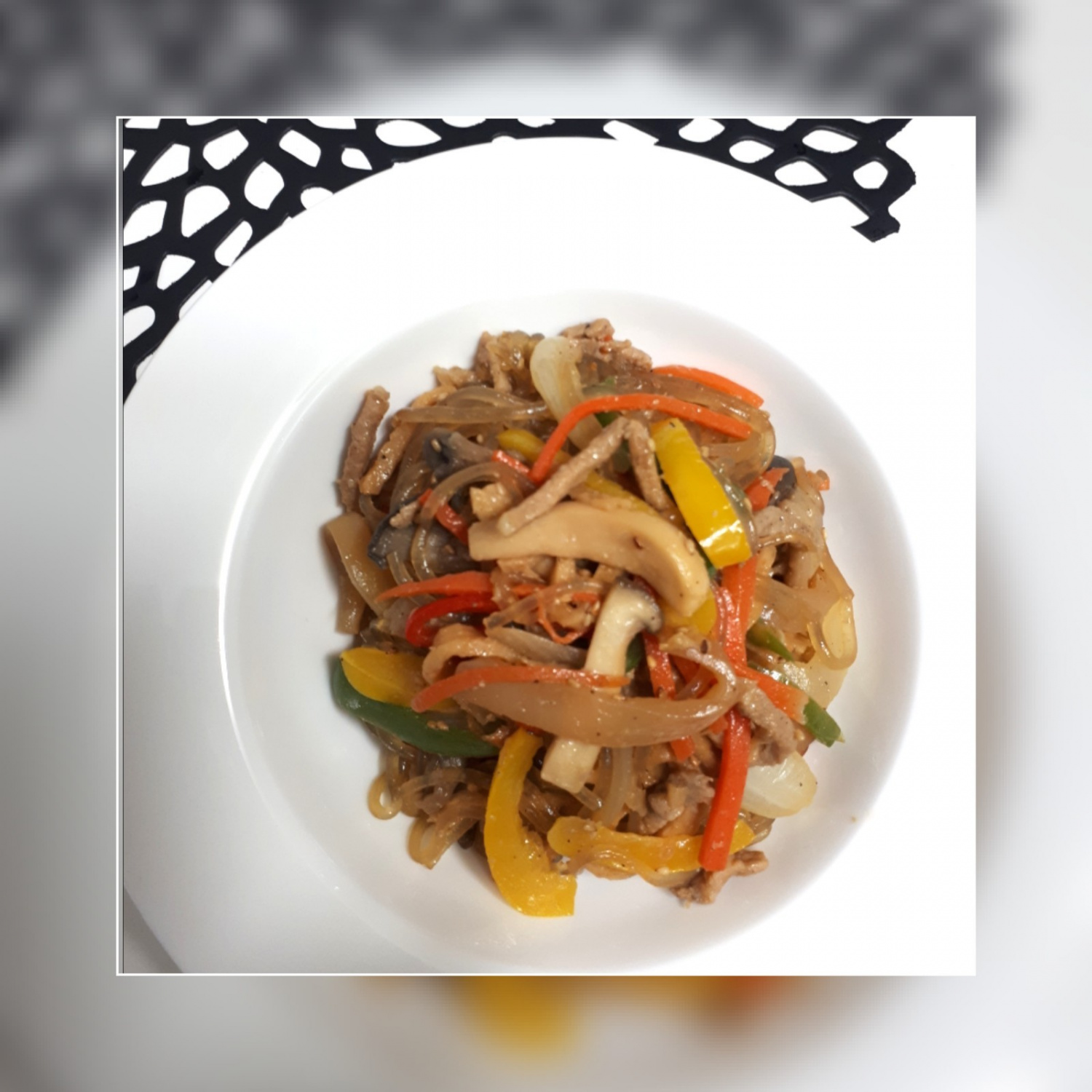Konjac Mushroom Japchae
A Healthy and Delicious Japchae with Konjac and Mushrooms

This is a fusion Japchae made with plenty of konjac and assorted mushrooms, reducing the amount of glass noodles for a healthier option. If your children are hesitant about eating mushrooms and konjac, this recipe is a great way to introduce them in a delicious and nutritious dish. Make a large batch, portion it, and freeze for quick and easy meals like Japchae-덮밥 (Japchae over rice) when you’re short on side dishes.
Main Ingredients- 500g Glass noodles (Dangmyeon)
- 600g Pork for Japchae (approx. 1.3 lbs)
- 1 packet Konjac jelly
- 1 large pack Oyster mushrooms
- 1 pack King oyster mushrooms
- 2 Onions
- 1 medium Carrot
- 2 Bell peppers (each color)
- 1 pack Fish cakes (thin, flat type)
Seasoning & Others- 1 bottle (500g) store-bought Korean BBQ sauce (for pork ribs)
- 5 Tbsp Soy sauce (Jinganjang)
- 2 Tbsp Sugar
- 2 Tbsp Salt
- 5 Tbsp Perilla oil (Deulgireum)
- 3 Tbsp Roasted sesame seeds
- 1 Tbsp Minced garlic
- 1 bottle (500g) store-bought Korean BBQ sauce (for pork ribs)
- 5 Tbsp Soy sauce (Jinganjang)
- 2 Tbsp Sugar
- 2 Tbsp Salt
- 5 Tbsp Perilla oil (Deulgireum)
- 3 Tbsp Roasted sesame seeds
- 1 Tbsp Minced garlic
Cooking Instructions
Step 1
To allow the flavors to meld, marinate the pork at least one day in advance.

Step 2
Pat the pork for Japchae dry with paper towels to remove excess blood. In a bowl, combine the pork, store-bought Korean BBQ sauce, and minced garlic. Gently mix well and let it marinate in the refrigerator. Pre-marinating is key to a delicious flavor.

Step 3
Soak the 500g of glass noodles in warm water until fully submerged. Using warm water rather than cold will help the noodles soften more evenly and become more pliable.

Step 4
Wash the bell peppers of various colors thoroughly. (If you prefer spinach, wash and prepare it at this stage. Green bell peppers can be used as a substitute for colorful ones.)

Step 5
Prepare the oyster mushrooms, king oyster mushrooms, one packet of konjac jelly, and thin, flat fish cakes. For added aroma and texture, you can include other types of mushrooms like shiitake or wood ear mushrooms. Enoki mushrooms tend to fall apart easily, so it’s best to avoid them for a neater presentation.

Step 6
Slice the konjac jelly as thinly as possible. Blanch it in boiling water with a pinch of salt and a splash of vinegar for about 1-2 minutes to remove any characteristic odor. Rinse under cold water and set aside, ensuring excess water is drained.

Step 7
Slice the onions, carrots, and bell peppers into approximately 5cm long strips. Avoid slicing them too thinly so they retain a pleasant chewiness.

Step 8
Cut the oyster and king oyster mushrooms into bite-sized pieces. Blanch them briefly in boiling salted water. (Tip: You can blanch the mushrooms first, then add a little vinegar to the same boiling water to cook the konjac.) After blanching, rinse under cold water and squeeze out any excess moisture.

Step 9
Slice the thin, flat fish cakes into easy-to-eat portions.

Step 10
Heat some cooking oil in a wok or large pan. Sauté the onions, then add the bell peppers and carrots. Season each vegetable with a pinch of salt as you stir-fry. Cook them just until they become slightly tender and translucent.

Step 11
Add the pre-marinated pork to the same wok (without adding extra oil) and stir-fry until it’s almost cooked through. Cook the pork separately to prevent it from sticking.

Step 12
As the pork cooks, it will release some juices. Push the pork to one side of the pan and add the fish cakes to the accumulated juices. Stir the fish cakes in the juices to let them absorb the flavor and cook until tender.

Step 13
Add the blanched konjac and mushrooms to the pan. Mix everything together and sprinkle with black pepper twice to enhance the flavors. Taste the mixture and add a little more Korean BBQ sauce if it needs more seasoning.

Step 14
Transfer the lightly stir-fried vegetables (onions, bell peppers, carrots) to a large bowl. Arrange the cooked pork, konjac, and mushrooms on top. The vegetables were only lightly sautéed so they would continue to cook gently in the residual heat and juices from the pork mixture, resulting in a moist and flavorful Japchae.

Step 15
Fill a large pot about halfway with water and bring it to a rolling boil. Once boiling, add 1 tablespoon of salt and the soaked glass noodles. Cook until the noodles are pliable. (Some people add soy sauce for color, but using only salt helps maintain the noodles’ original flavor.)

Step 16
When the glass noodles are about 80-90% transparent, turn off the heat and drain them in a colander.

Step 17
Crucially, do NOT rinse the drained noodles under cold water! Shake them vigorously in the colander to remove excess water. (Rinsing washes away the starch, preventing the noodles from absorbing flavor and making them taste bland.) To handle the hot noodles without burning your hands, wear a pair of cotton gloves followed by disposable kitchen gloves.

Step 18
Place the drained noodles on top of the ingredients in the large bowl. First, season only the noodles with soy sauce, perilla oil, and roasted sesame seeds, mixing them gently. Once the noodles are seasoned, combine them thoroughly with all the other ingredients (vegetables, pork, konjac, mushrooms). Taste and adjust the seasoning with more soy sauce or a touch of sugar if needed.

Step 19
Children often prefer Japchae that is slightly sweet. If you enjoy a spicier kick, finely julienne some Korean red chili peppers (cheongyang peppers) and mix them in before serving for an extra layer of flavor.




